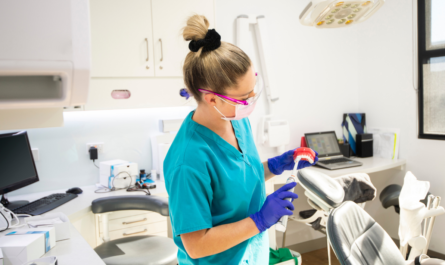Gloves today are thinner – and offer greater durability – than their predecessors.
When selecting the best glove solutions for a dental practice, a lot depends on personal preference. Factors such as flexibility, tactile sensitivity, cost and the potential for allergic reactions to certain glove materials all come into play. “There is no one glove that fits all,” says Alen Kwong, Business Development, Cranberry®. “However, all gloves should provide the comfort and protection that allow dental professionals to work safely in their environment.”
The good news is that many gloves today – whether latex, nitrile or another material – are thinner, facilitating greater tactile sensitivity, yet more durable than in years past.
Know your options
There are pros and cons to every glove type, notes Kwong.
- Latex. Latex gloves have long been considered a trusted glove material for dental markets. Made from natural rubber latex, these gloves are known for their flexibility and fitment properties, as well as their ability to offer reliable barrier protection. That said, some practitioners and patients have allergic reactions to latex gloves, widely deterring their use.
- Vinyl. A more economical option than latex, vinyl gloves are made with polyvinyl chloride and are free of latex allergens. Glove wearers, however, often feel vinyl gloves do not offer the same flexibility as latex gloves.
- Made with synthetic rubber, nitrile gloves offer nearly the same flexibility and durability that latex gloves provide. Not long ago, some doctors considered nitrile gloves too expensive to purchase. However, newer generations of nitrile gloves have come down in price, and today they are thinner than latex gloves, while retaining their durability. That said, there have been growing concerns over allergic reactions to the chemical accelerators used in nitrile glove manufacturing. As a result, new accelerator-free nitrile gloves are becoming more popular.
- Polychloroprene. Due to the growing concerns over allergic reactions to the chemical accelerators used in nitrile glove manufacturing, accelerator-free nitrile gloves – or polychloroprene gloves – have become more and more popular. Not only are polychloroprene gloves not associated with allergies, their synthetic rubber content is said to closely match the flexibility and barrier protection offered by latex gloves.
“Some dental professionals may find it confusing that different gloves are packaged in different quantities, ranging from 100 to 300 gloves per box,” says Kwong. That said, it’s possible to calculate a standard unit of cost across the board. While it’s important to make economical choices, however, it never pays to save money at the expense of staff and patient safety.”
Never settle with your hands: Inspire Nitrile
Don’t settle for just any glove. Cranberry offers a full range of nitrile gloves, including their newest offering: Inspire. Dental professionals will appreciate the great fit and comfort Inspire gloves offer. Weighing only 2.5 grams, Inspire is the lightest nitrile glove available for dental professionals, and features less constraint, more control and greater tactile sensitivity. The glove’s light weight facilitates enhanced fingertip texture, extension and flexion throughout the clinical procedure, while the InSoft formulation minimizes hand fatigue and provides superior grip for increased comfort and better performance.
Source: Cranberry





